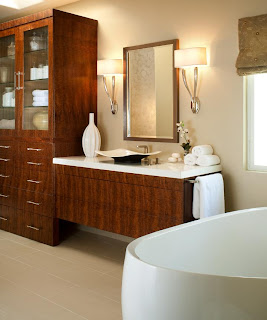
As we close the week of posts, I'd like to talk about modern design. Taking a look at the home furnishings and decor markets, you can see that modern style is considered the new classic in design. It began with the Bauhaus movement in the 1920's, and the simplicity and functionality of furnishings and fixtures makes it ideal for people who love clean lines and classic forms. It's not always easy to incorporate these elements into traditional decor since they can be stark and strong. Consulting with a professional is sure to result in the perfect marriage of two different styles.

As these photos show, modern style is evidenced by simple geometry with minimal detail (no carvings, moldings and the like), neutrality of color, and starkness of accessories. Warm wood tones, textural elements and architectural details like exposed beams, open stair and railing systems and interesting dimensions and positions of walls or room dividers is common.
 Modern design commonly incorporates new materials and techniques. The most common materials are metal, glass, and concrete. Metal, obviously, isn't new, but its use in architectural elements, on surfaces, and even cladding case goods, emphasizes simplicity. Metal creates a crisp, no-nonsense feel. Its sleekness is a fabulous contrast to and enhancement for other decorative elements like wood floors, cabinetry and furnishings.
Modern design commonly incorporates new materials and techniques. The most common materials are metal, glass, and concrete. Metal, obviously, isn't new, but its use in architectural elements, on surfaces, and even cladding case goods, emphasizes simplicity. Metal creates a crisp, no-nonsense feel. Its sleekness is a fabulous contrast to and enhancement for other decorative elements like wood floors, cabinetry and furnishings.Glass - hand blown in light fixtures or clear or textured in walls, windows and stairways - creates an artistic element. A stunning metal and glass staircase can be as much an artistic feature as a colorful glass light fixture or piece of sculpture. New methods of forming glass has enabled the creation of textured panels that can become walls and doors.
Decorative concrete too, has new techniques for installation and finishing. Floors, countertops, and furniture are great places to apply concrete. Many homeowners are still unaware of just how versatile and beautiful concrete can be.
 You should never underestimate the right use of color and lighting in any interior, and that's especially true for modern style. Leaning toward simplicity, using neutrals like beige, white, and brown is common but beware of hues and application so spaces don't look muddy and institutional. Neutrals can be complemented with vibrant accent colors in art, accessories, fabrics and more so simplicity is not boring, is the mantra here.
You should never underestimate the right use of color and lighting in any interior, and that's especially true for modern style. Leaning toward simplicity, using neutrals like beige, white, and brown is common but beware of hues and application so spaces don't look muddy and institutional. Neutrals can be complemented with vibrant accent colors in art, accessories, fabrics and more so simplicity is not boring, is the mantra here. Lighting is often used to feature areas of interest; architectural elements, artwork. Track lighting and floor lamps are popular, but recessed wall washer, shelf lighting, accent pendants, and wall sconces can be installed as accent lighting.
Combining these elements in a strictly modern interior is exciting and dynamic. If you need a bit of help and guidance for the right materials, furnishings and lighting,it's the perfect time to consult with a designer.

